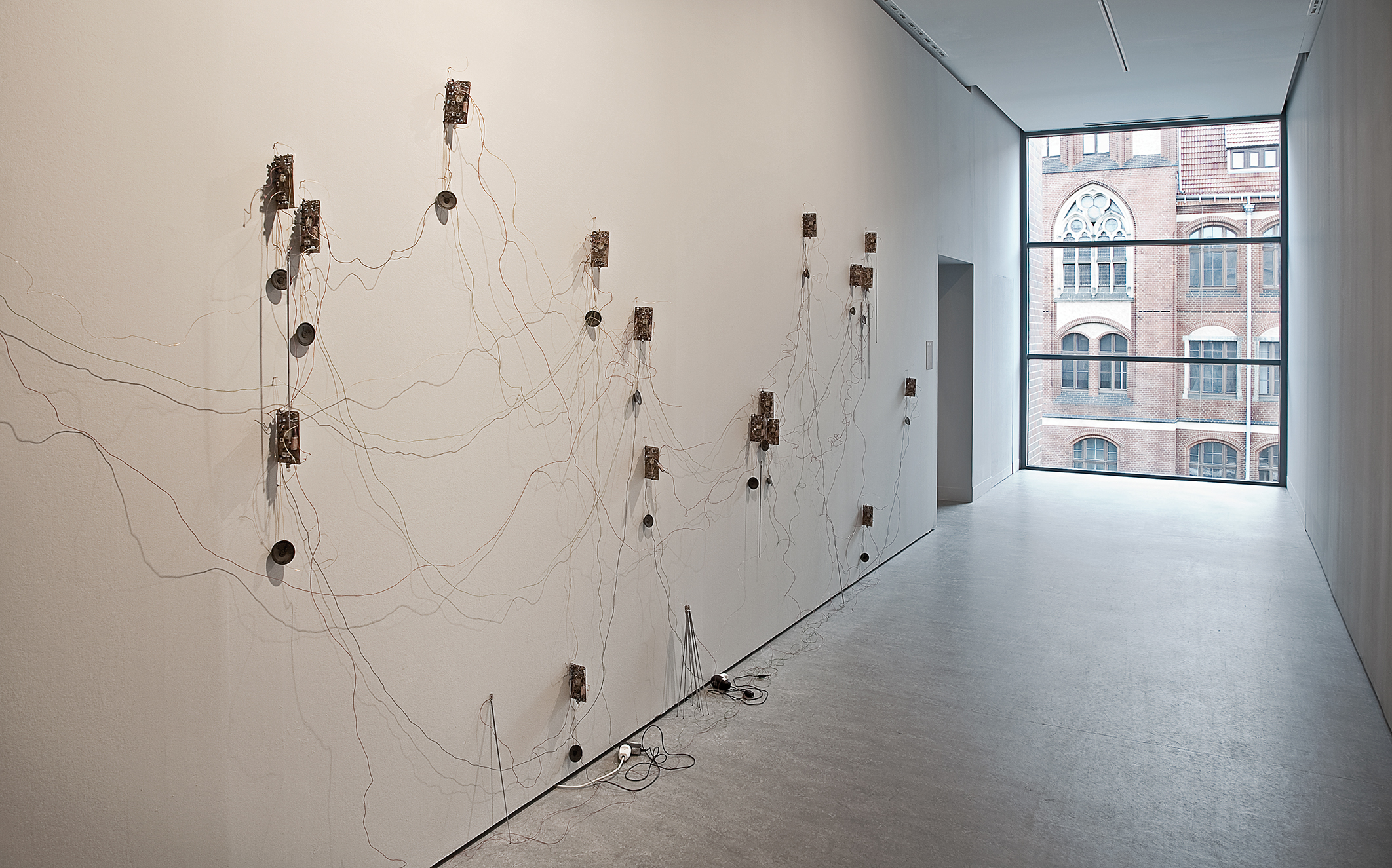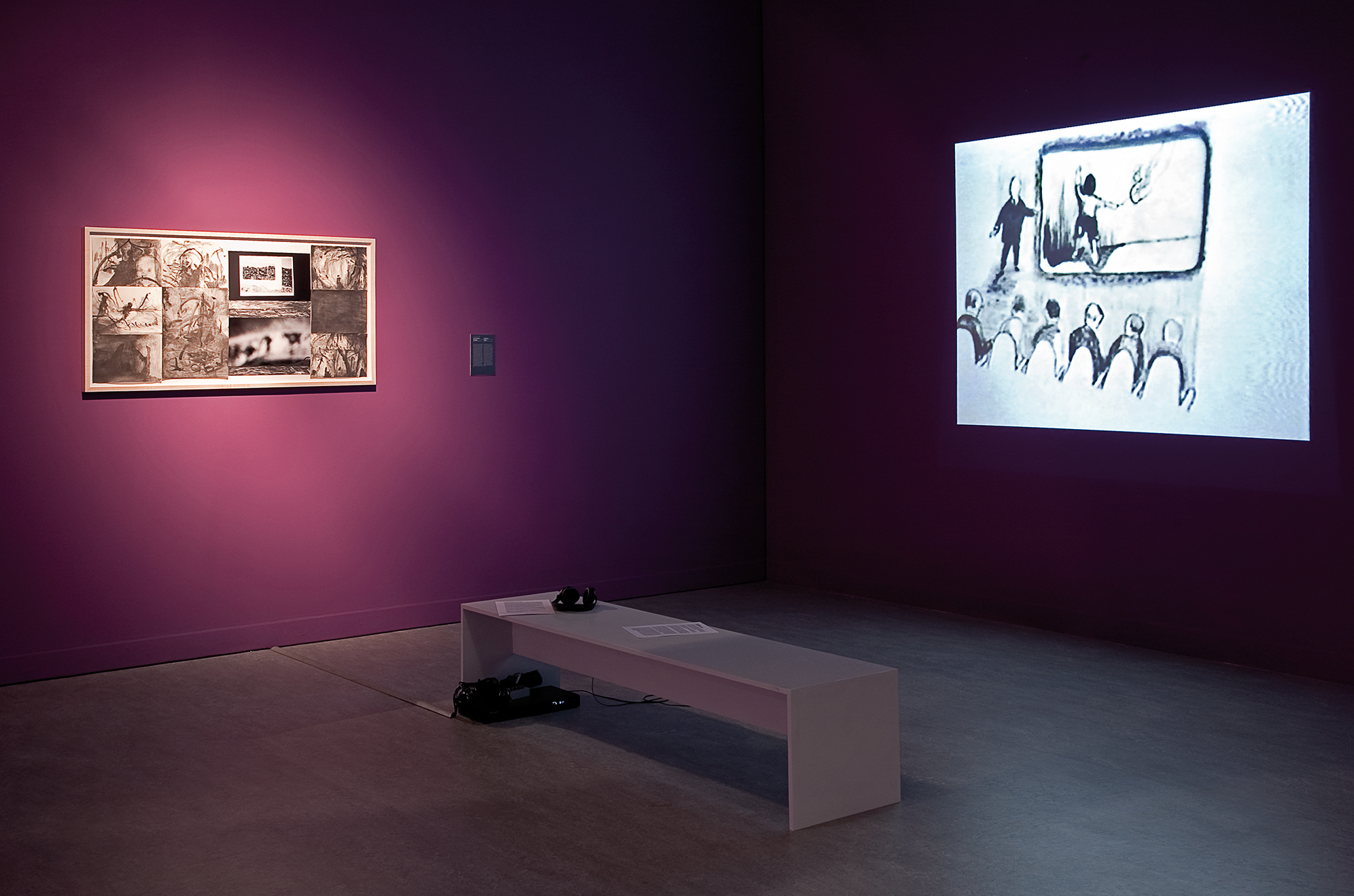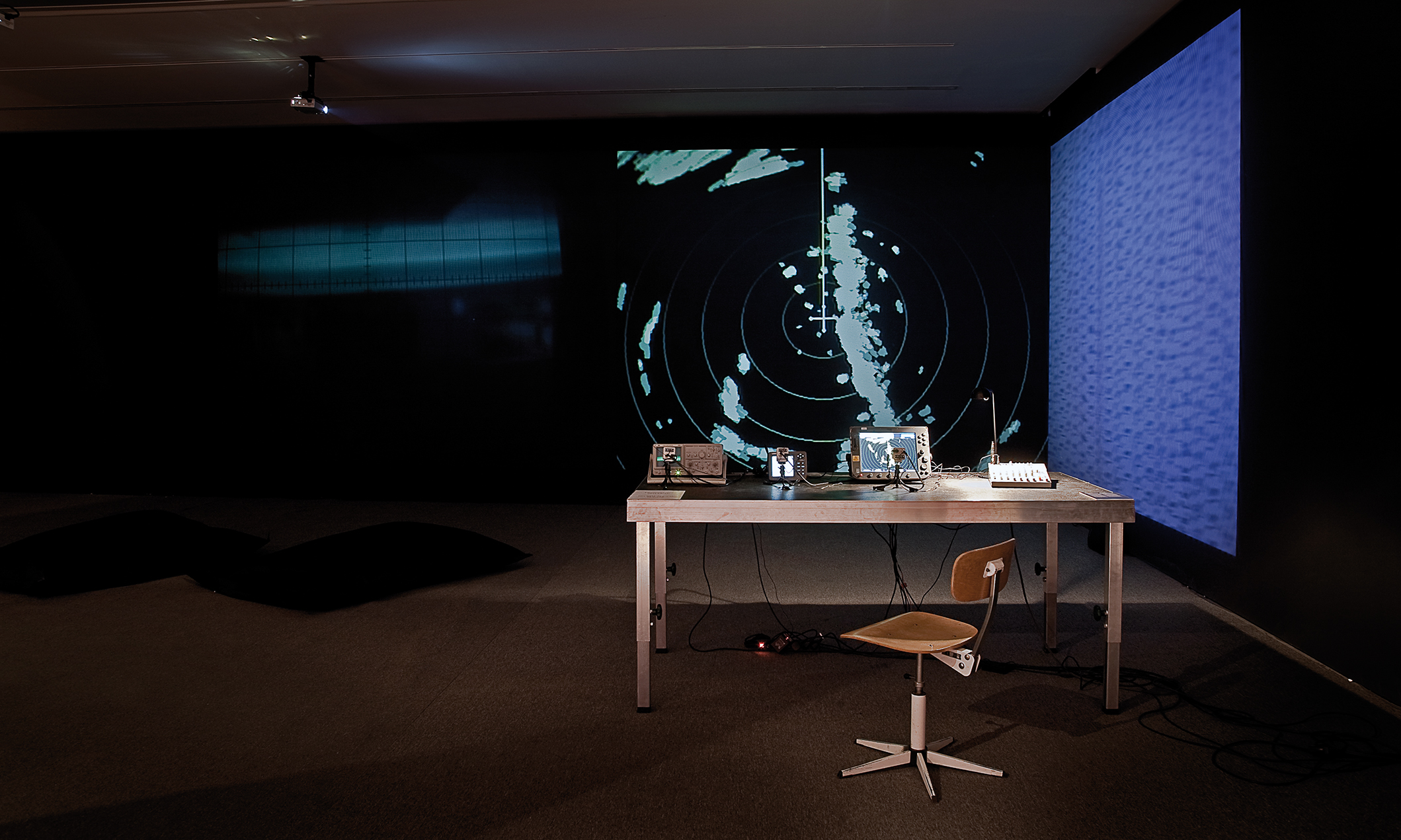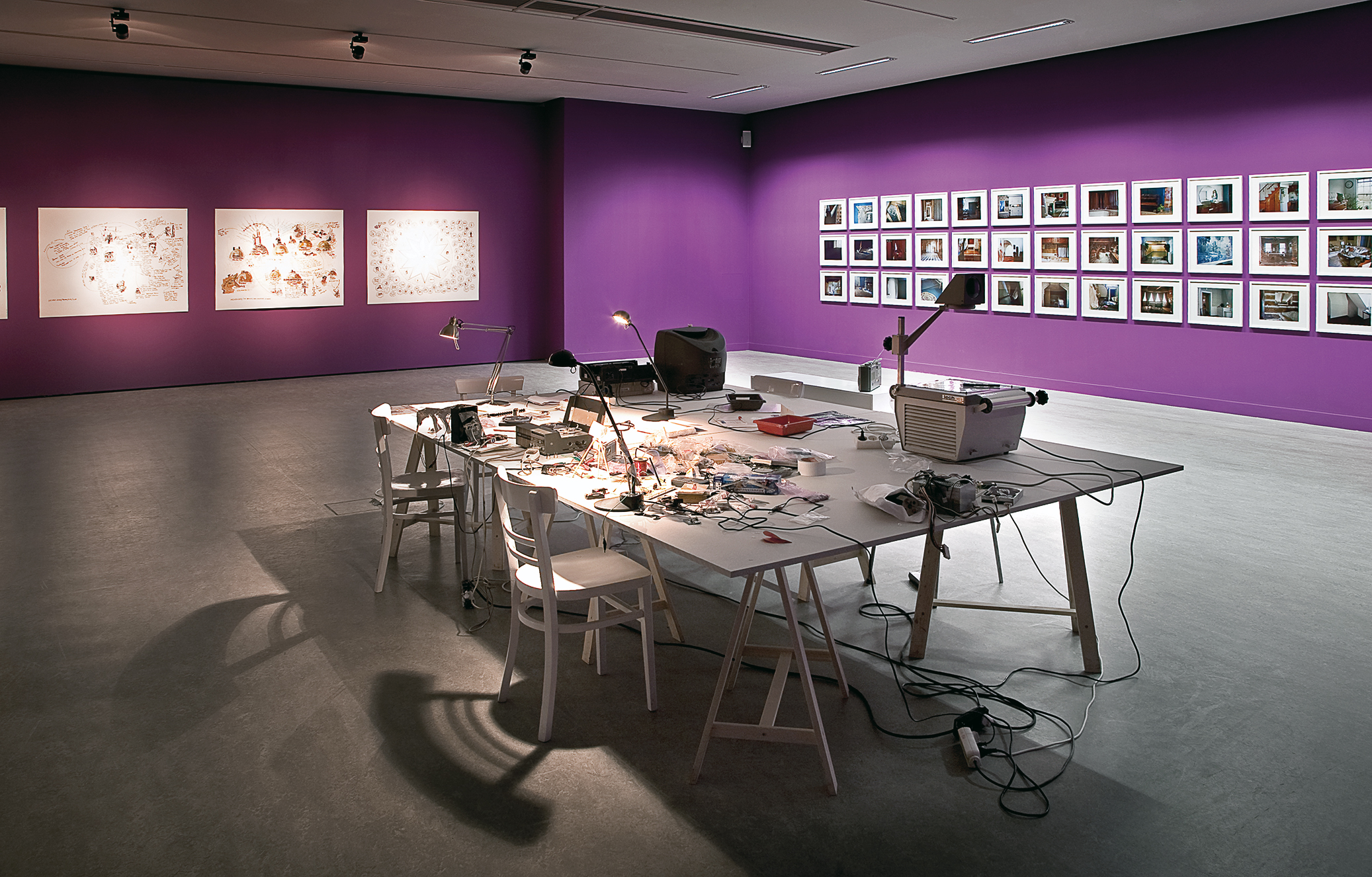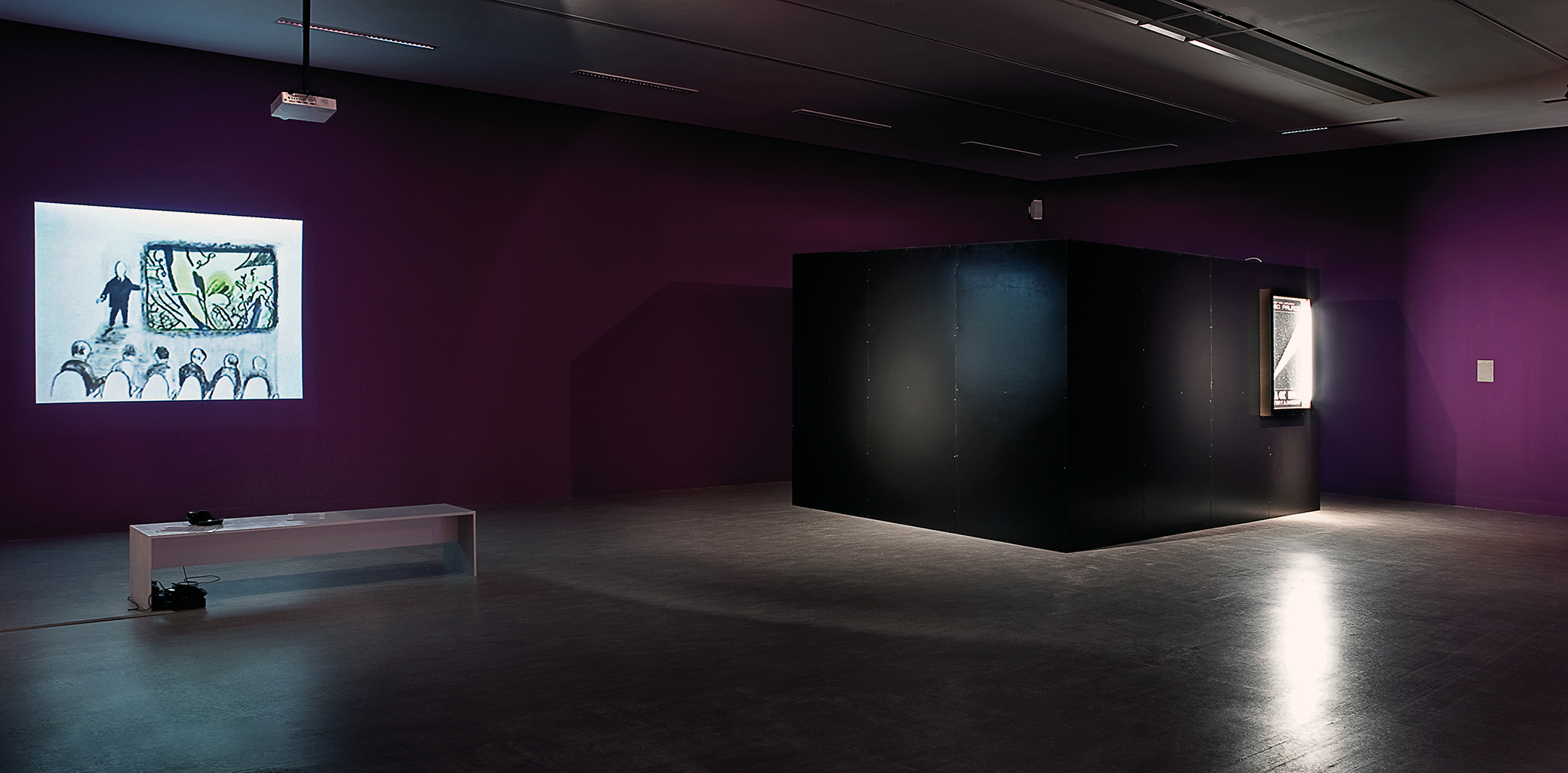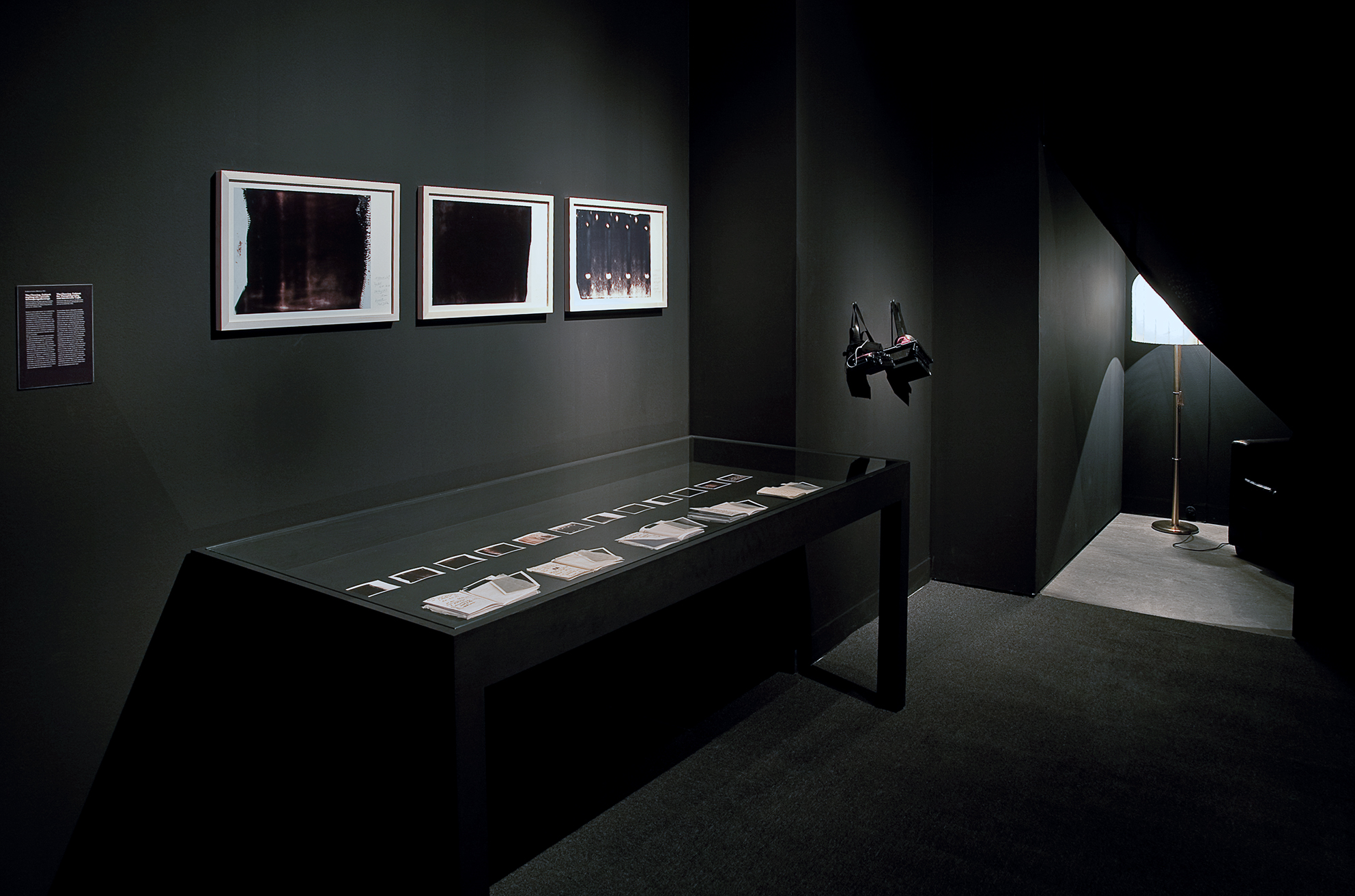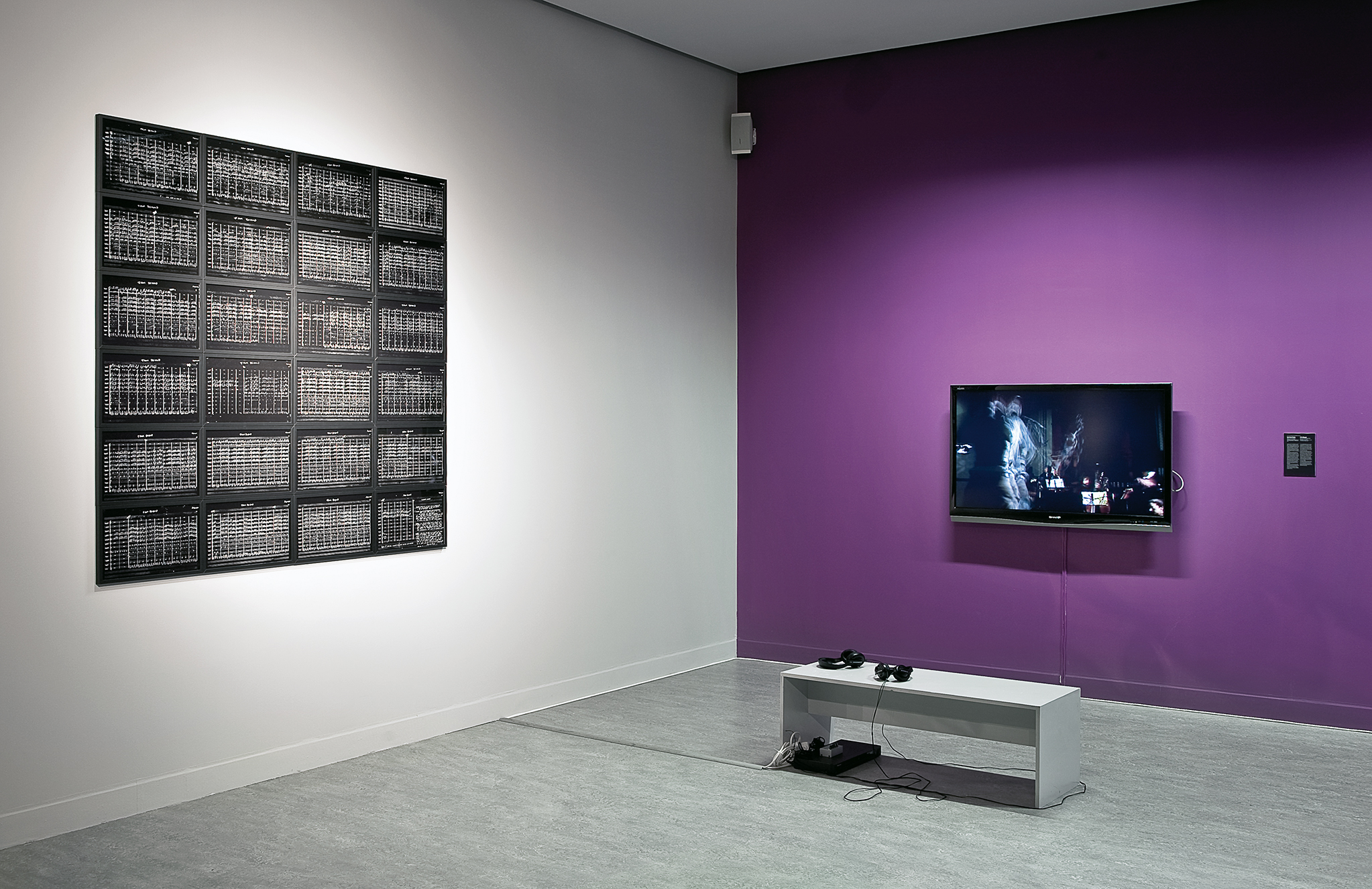Wach sind nur die Geister
The exhibition ‘Awake Are Only the Spirits’ – On Ghosts and Their Media is dedicated to a topic that appears, at first glance, timeless: it involves the presence of the supernatural – the appearance of ghosts and (trans-)communication with ‘the beyond’ facilitated by technical media. The exhibition begins with the audio-tape archive of Friedrich Jürgenson who discovered the so-called Electronic Voice Phenomenon (EVP) in 1959. As a result of the strong interest in the topic on behalf of contemporary artists, the exhibition questions why – despite our faith in the rational – at regular intervals irrational properties are ascribed to respective new media and technologies, such as those purportedly serving as channels for messages from ‘the beyond’. The exhibition shows 22 international artistic positions questioning the existence of ghosts, exploring the integration of new media and technologies in spiritualist contexts, investigating the making-visible or making-perceptible of the invisible, and tracing the political implications as well as the aesthetics of such contemporary trans-communication phenomena.


Legend
Once upon a time a little boy on his way home from junior high school discovered a very convenient shortcut. To get from his school to the underground he could choose between two options. The first was to skirt a large ground by following a succession of pavements lit by sodium street lamps. Although this path was the safest, it wasn’t the shortest, and I should add that most cities in the north of France do not really encourage Benjaminesque flânerie or Situationist dérive. And so the young boy soon got bored treading the same monotonous boardwalks. The second path, which was much faster, led across the abovementioned large ground. In the end, it was a matter of geometry: there is no shorter path between two points than the straight line. But for this path to be taken, classes had to finish early (if my memory is right, the ground was shut down at 5 pm) and the boy had to overcome his fear, since the large ground was in fact a cemetery, which even today seems huge to me (though childhood memories tend to be inflected by vastly different scales). The town is called Hellemmes, the school Antoine de Saint-Exupéry, and the cemetery, according to the map I’m holding in my hands, is hardly 500 metres long.
Cemetery
Cemeteries are essentially strange places. They associate the notion of death with that of eternity engraved in stone (that is, as long as the heirs keep paying the concession fees), and one sometimes stumbles over artfully sculpted graves which are nothing short of remarkable. Cemeteries are often like patches of nature or landscape in the midst of overcrowded cities, genuine urban parks where, for instance, Jim Morrison’s or Serge Gainsbourg’s fans can approach their idols with the assurance that they won’t mind being photographed.
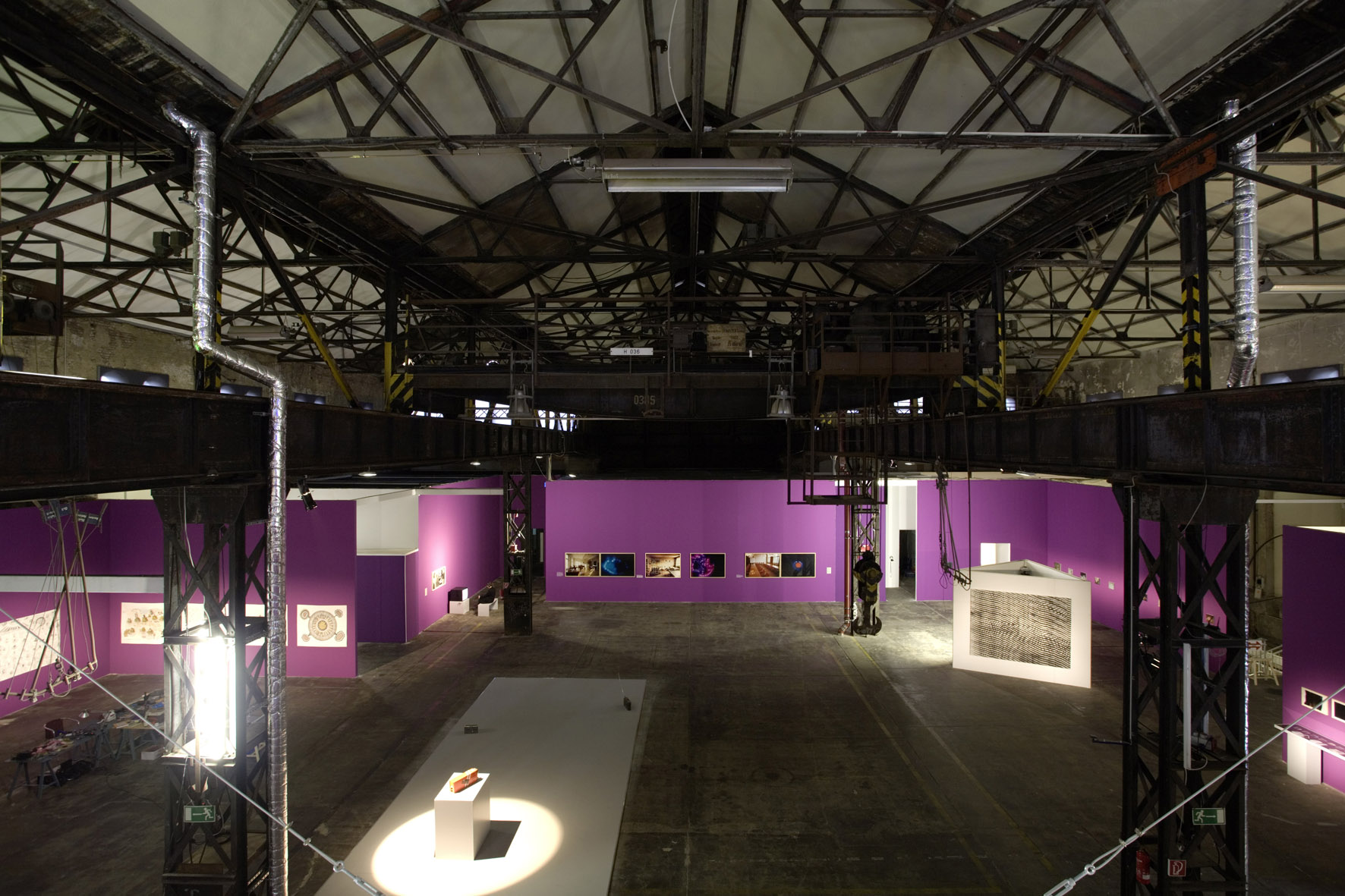
Every dictionary that deserves its name should have an entry under “EVP”, which could read as follows: “EVP, acronym for Electronic Voice Phenomena. Electro-acoustic manifestations discovered in the early 1960s on magnetic tape recordings of white noise on unused radio frequencies and considered by spiritualists to be voices from the dead.”
Electricity
There wouldn’t be anything particularly strange about crossing a cemetery several times a week if it weren’t connected to EVP and, hence, to the subject under discussion here. It turns out that while as a young boy I was walking along this particular path, I learned to unconsciously associate two notions: death and electricity. As a matter of fact, depending on the weather, that cemetery was filled with sounds the likes of which I have never heard again since. I should point out that the engineers from the electrical company had found an intelligent solution to a serious problem by installing a giant electrical substation on a large patch of ground adjacent to the cemetery. The idea was to avoid that the locals complained about potential disturbances or interferences in their TV sets caused by the electric current. I should also specify that Northern France has a particularly humid climate (the sea is less than a hundred kilometres away) and, depending on the day, on the concentration of humidity in the atmosphere, on the size of the clouds, the amount of sunshine or the season, the current flowing through the cables and the giant substation started to crackle. You never heard the same sound twice (once again, I should attract the reader’s attention to the fact that I’m recollecting events dating back to more than twenty years, which is why it is quite likely that my memory should have magnified them), but I remember the delicate and subtle yet perfectly audible noises that used to accompany my crossing of the Hellemmes cemetery. It was like a cloud of sound through which the atmosphere seemed to materialise. This could well be the reason why, towards the end of the 1990s, I was particularly receptive when I first heard the recordings of Friedrich Jürgenson. They reminded me not only of the aesthetic of the noises I had heard in my youth, but also of the idea that strange sounds could be linked to death and the beyond.


Discovery
Friedrich Jürgenson’s discovery is, in every sense of the word, phenomenal. Like many people who have survived a world war, Jürgenson saw more friends die than any European of our generation. Spiritualism is not merely a pastime or a whim, but more importantly it reflects an individual’s profound desire to get in touch and communicate with those he or she has lost over the years. So in 1959, when Jürgenson’s magnetic tape recorder produced unexpected and hitherto unheard-of glitches, it didn’t take long for the Swede to realise that he was witnessing paranormal phenomena. His life, which had been deeply affected by the tragic events of the 20th century, had made him particularly receptive (no doubt he wanted to believe and to communicate) and his technical gear was so sophisticated (for its time) as to be beyond doubt. On Friday, 12 June 1959, Friedrich Jürgenson was taping bird songs in the rural environs of Stockholm when, in the middle of his recording – amidst noises anyone else would have identified as a technical bug – he heard a trumpet followed by a human voice speaking in Norwegian about “birds singing in the still of the night”. For Jürgenson, what might have been a simple radio interference soon became a message from the other world encouraging him to take up scientific research, an endeavour he would pursue until his death in 1987. Jürgenson was prepared to hear, and I, thanks to my childhood experience, was prepared to listen to him.
Music
I should briefly point out that my musical tastes, ranging from US-American minimal music and Pierre Henry to Einstürzende Neubauten, have conditioned my perception to refrain from systematically tracking the catchy rhythm, the pleasing or harmonious melody. Along with the legend about the cemetery, this surely helps to explain why my first hearing of a recording of Electronic Voice Phenomena was a rather more important revelation than the discovery of life after death.


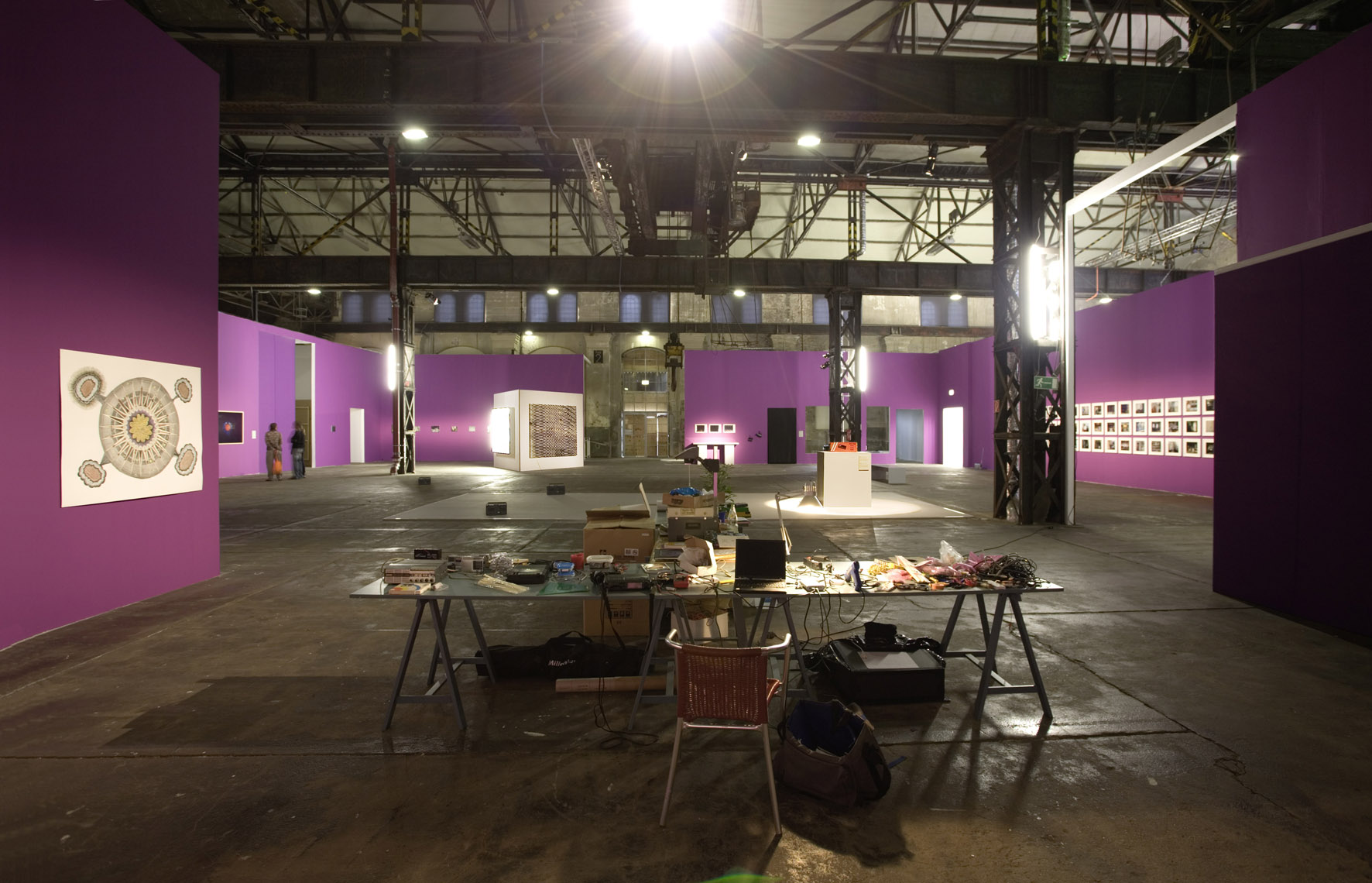
With the help of the voices from the other world advising and instructing him on how to refine his technology, Friedrich Jürgenson quickly developed a scientific principle of communication. Choosing unused radio frequencies whose white noise he recorded on magnetic tape, he patented a spiritualist methodology that would be adopted throughout the world. Its disciples could be found in Sweden (the Latvian national Konstantin Raudive), Great Britain (Raymond Cass), Italy (Marcello Bacci), Germany (Gerhard Stempnik, principal oboist with the Berlin Philharmonic), and still today organisations in Germany and the United States perpetuate and refine Jürgenson’s technological principle. Jürgenson kept listening to his magnetic tapes, again and again, tracking the slightest anomaly, which he then interpreted with the help of the many languages he spoke (Swedish, German, Italian...). The voices from beyond, so it appeared, had a distinct preference for multilingual messages, sometimes using several languages in the same sentence, a circumstance Jürgenson took as irrefutable proof of their supernatural provenience. For who else but ghosts would take pains to combine languages in trying to communicate?

It may seem strange but there is a striking beauty to the recordings made by Jürgenson (and his many colleagues). First a voice – that of the spiritualist – announces the nature of the recording and explains what listeners are supposed to be hearing in the following excerpts. This announcement is followed by the clicking sound of a button being pushed down. Then comes the far-away voice, drowned in crackling, hissing and distorted noises. For a better understanding, the scientist rewinds the tape and plays it once more (three times on average), and while doing so, quite audibly fiddles around with the fast forward and fast reverse buttons of his machine. All this sounds rather chaotic and disorderly, like someone tinkering with a messy bunch of recorders, radios, cables and microphones. The result is actually quite close to the experiments conducted by Pierre Schaeffer and Pierre Henry (the inventors of Concrete Music), who towards the end of the 1940s – meaning barely ten years before Jürgenson’s discovery – started cutting up and reassembling large magnetic tapes. Chances that Jürgenson, a classically trained opera singer, was interested in the French composers’ experiments are slim, and his recordings have a different purpose anyway. The fact that they are beautiful and that I enjoy listening to them – all this is both fortuitous and the result of my education. Trained by the various experiments of avant-garde music and its pop equivalent, “industrial music”, the modern ear can listen to EVP archives with a different intention or desire than just hearing the dead talk. And it can do so with a certain pleasure.
Science
One of EVP science’s most important contributions to spiritualism was the use of top-notch technology, which effectively propelled this particular realm of crackpot science from stuffy candle-lit backrooms into the realm of academia and research.

A classic piece of Conceptual Art and Sound Art. In 1969 Alvin Lucier sat down in a room and recorded the first version of I Am Sitting in a Room. Its premise is of almost ludicrous simplicity. The composer recorded himself reading a text out loud, and once the recording was done, he played it back in the same room and recorded it once again with a microphone. He then played back the recording of the recording in order to record it, etc. For the best-known version of this work, which was produced in 1980 and released on CD, he repeated the operation no less than thirty-two times, sitting in his apartment on 7 Miles Avenue, Middletown, Connecticut. What relates this work to Conceptual Art is the content of Lucier’s text, which simply explains the production process of the work (its score, so to say): “I am sitting in a room different from the one you are in now. I am recording the sound of my speaking voice and I am going to play it back into the room again and again until the resonant frequencies of the room reinforce themselves so that any semblance of my speech, with perhaps the exception of rhythm, is destroyed. What you will hear, then, are the natural resonant frequencies of the room articulated by speech. I regard this activity not so much as a demonstration of a physical fact, but more as a way to smooth out any irregularities my speech might have.” The result is astonishingly musical, and while in the early stages of the recording, you still hear and understand the voice, halfway through the forty-five minutes, there’s nothing but a long wave of sound with incremental variations. The thirty-second passage sounds at best like a kind of extraterrestrial flute no synthesizer could have produced and no scientist imagined. But what’s most amusing is that I Am Sitting in a Room also sounds like a Spiricom (a transcommunication device based on emitting pure frequencies rather than recording radiophonic white noise), except that Lucier’s working method is the exact reverse of the EVP scientists’. While the latter attempt to unravel what is hidden among the waves, the former tries to blur what is clear from the very first line. And if that’s incredibly beautiful, both as regards the idea and its implementation, but even more so as regards the sounds resulting from this method, it is mostly the artist’s misappropriation of technology that recalls EVP practices. The microphone is held up “in the air” and listens to the tape recorder at the other end of the room, with enough space between them to allow for all kinds of interferences (and distortions). The technical instruments may be simple but their use is particularly inventive and creative. Here, the voice shifts from figuration to abstraction, while EVP practice, which teaches us to listen to what lies beneath the veil of sound, moves from abstraction to figuration.
Misuse
Beyond its aesthetic aspect, EVP science, its practice and technology, can also be considered under the angle of its misuse of technology. Here comes another childhood memory, which will no doubt clarify this statement... The kind of spending money I had did not allow me (far from it) to buy all the records I wanted. I had therefore figured out that by connecting a cable to the headphone socket of our TV set, I could hook up my small portable cassette recorder (instead of a loudspeaker). Thus equipped I would wait for Saturday night and the mythical show Les enfants du rock, and all I had to do was to start the recording, which would subsequently end up in my first Walkman. I recently tutored a series of workshops on EVP in a couple of art schools and was astonished to see how “dependent” and “passive” we have become in relation to the technology that surrounds us. It has to be said that digital devices in particular are more and more being designed with the intent to prevent users from making errors. Difficult indeed to connect a USB cable to a power socket, just as it has become nearly impossible to connect something “the wrong way round” (on account of most connectors and machines being equipped with so-called mistake-proof devices against any manipulation that could result in irreparable damage). Yet how often have I seen people wasting hours trying to send an email without even considering to pick up the phone and call instead? What EVP scientists teach us – and this applies both to everyday life and a substantial number of works in this exhibition – is that you have to be inventive as regards the use of technology. And that you shouldn’t be afraid to stick your finger in the power socket if you want to create something new. Misuse is the key to success for anyone who tries to make the impossible possible and, more importantly, it denotes a “creative” relation to the objects that surround us.
U2
At the end of January 2009, I read in a daily paper that for some time before its release the new U2 album had been available on peer-to-peer websites thanks to a fan who had used his mobile telephone to record the tracks straight from Bono’s stereo in his villa on the French Riviera... What if on this bootleg recording, which reminds me of the good old days of music cassettes which we copied and traded in the school yard, U2’s album sounded better than on CD?


As I was writing this I discovered a short video in which a guy explains how to transform the joystick of a popular video game console into a genuine Theremin (also called “etherwave violin”, this fabulous instrument invented around 1920 is controlled without physical contact)... Of course, technically speaking, that takes more know-how than connecting a tape recorder to a TV. It takes a fair bit of tinkering, adapting, soldering and computer programming as well some basic kit (a computer, a synthesizer, electronic switchboards...), but it’s nevertheless proof that even today disrespectful users are capable of inventing and misappropriating technology – with the difference that the purpose seems to have shifted from an existential quest (communicating with friends who have died) to basic entertainment (having fun with friends who are still alive). As a daily user of new technologies, though not an expert (my use of them remains “passive”), it get the impression that with respect to digital media, creativity has largely shifted from the hardware to the software. The fact, for instance, that you can phone the world for free with Skype, a software using the Internet to transmit the human voice, is an idea of stunning simplicity yet incredible efficacy, but it could certainly be misappropriated for other purposes. But do ghosts have access to broadband Internet? And is there anyone still willing to listen to them?
UHER
We are at least in part the result of our past encounters and experiences. And some dead haunt us long after their burial. Memories of a friend who committed suicide when we were still in our teens keep coming back, and learning that someone with whom we used to be in contact just passed away can cause tremendous sadness. Beyond the feeling of loss as such, these moments remind us that we too are mortal beings. I have not set foot in the Hellemmes cemetery since the end of the 1980s. But like everyone else, I still like to scare myself by watching horror or ghost movies. On the other hand, even though I was recently given a UHER magnetic tape recorder of the same kind than Jürgenson’s, I never tried any of the techniques invented by the EVP buffs. Maybe I simply prefer to stroll through museums on Sundays and imagine what my friends would be like if they were still alive.
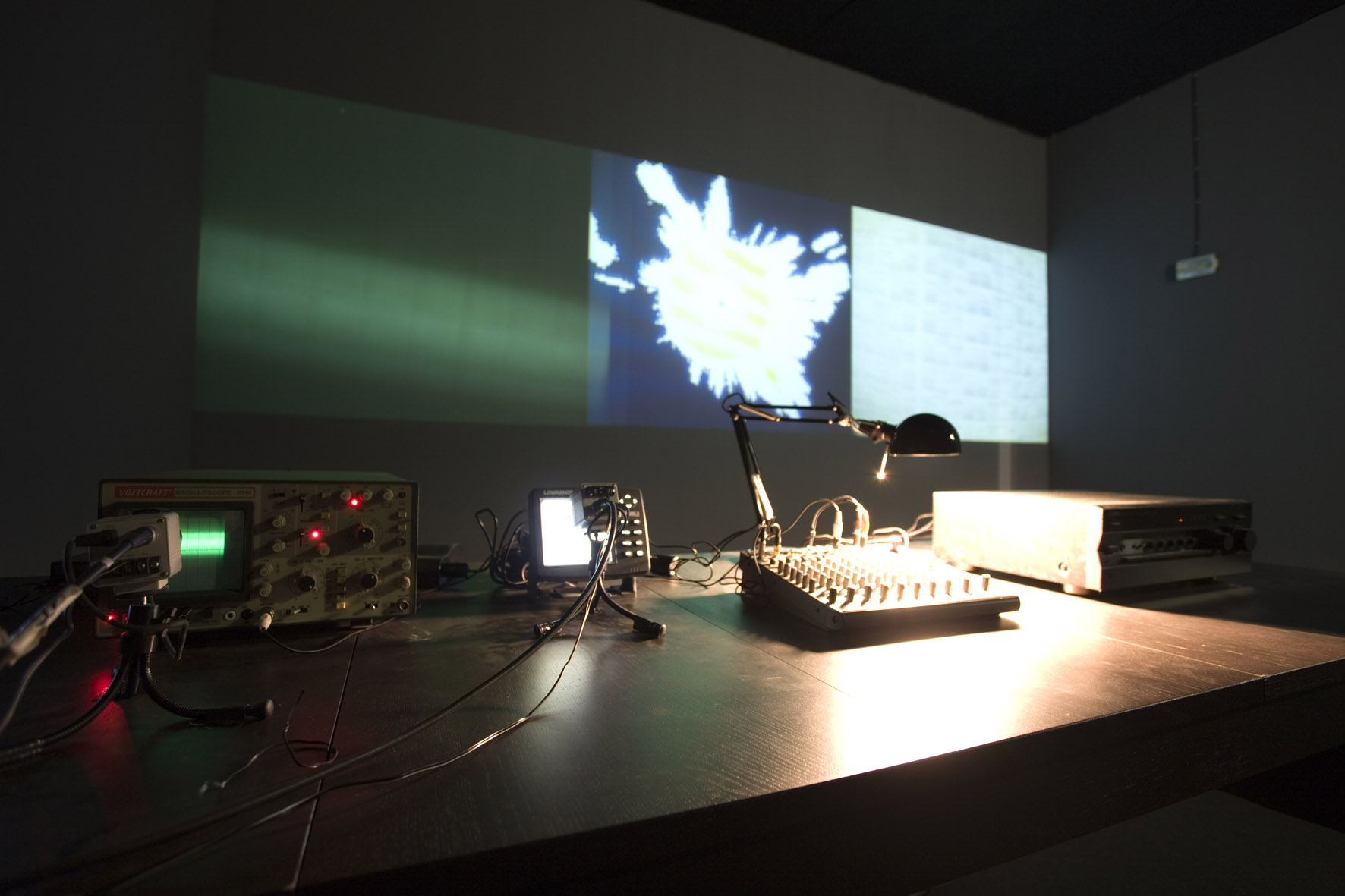
Wach sind nur die Geister
HMKV in the Phoenix Halle, Dortmund (Germany)
May 16 — October 18, 2009
Curated by Thibaut de Ruyter & Inke Arns
Exhibition architecture: Thibaut de Ruyter
Artists: Lucas & Jason Ajemian, Archiv eines anonymen Geistersehers kuratiert von hans w. koch, Sam Ashley, Corinne May Botz, Erik Bünger, Damien Cadio, Michael Esposito, Nina Fischer/Maroan el Sani, Agnès Geoffray, Kathrin Günter, Carl Michael von Hausswolff, Tim Hecker, Susan Hiller, Martin Howse, International Necronautical Society, Friedrich Jürgenson, Joep van Liefland, Chris Marker, Jorge Queiroz, Scanner, Jan Peter E.R. Sonntag, Suzanne Treister
after Dortmund the exhibition was presented at the CoCA (Center of Contemporary Art), Torun (Poland)
March 27 — May 30, 2010

